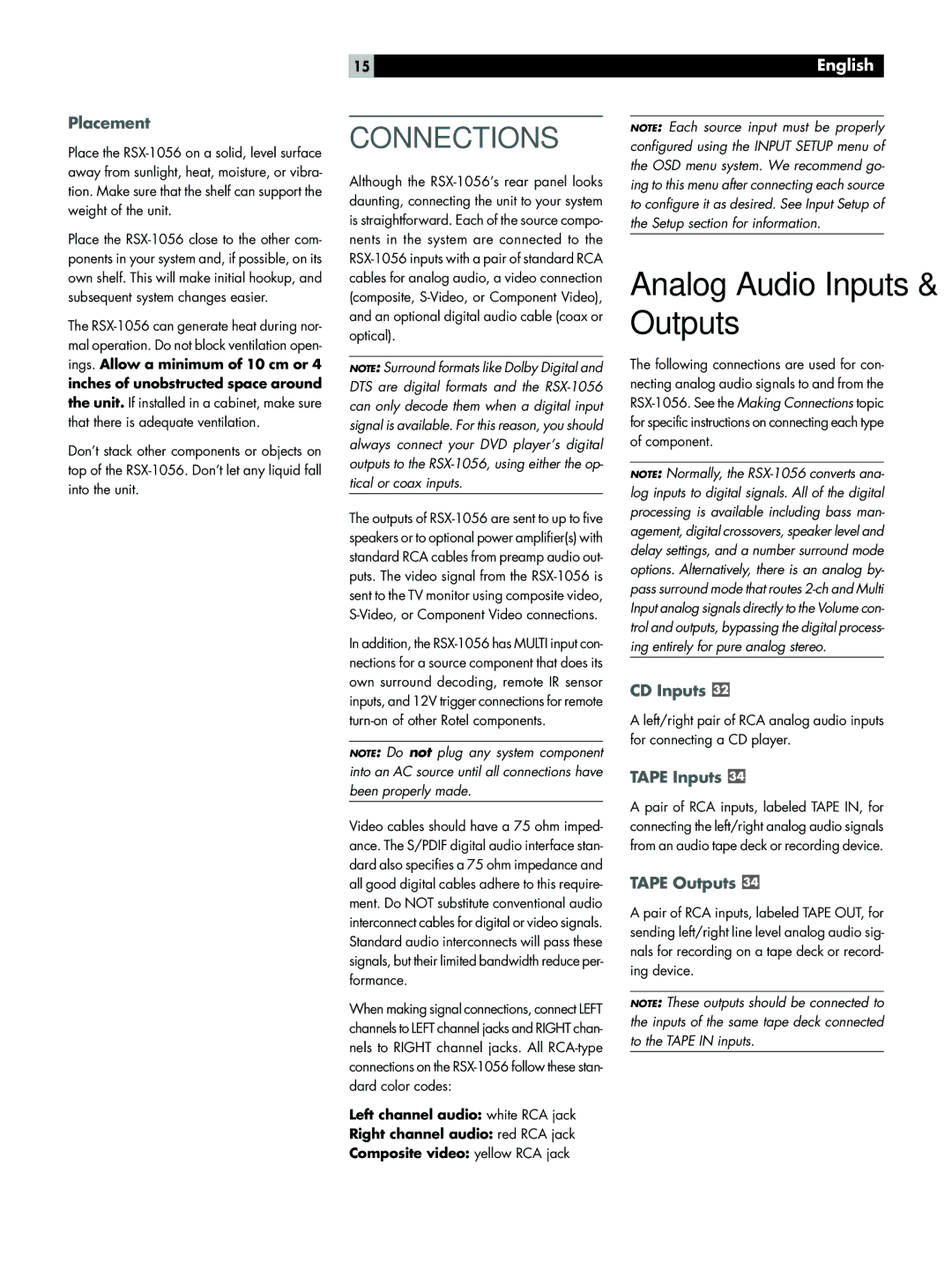Placement
Place the RSX-1056 on a solid, level surface away from sunlight, heat, moisture, or vibra- tion. Make sure that the shelf can support the weight of the unit.
Place the RSX-1056 close to the other com- ponents in your system and, if possible, on its own shelf. This will make initial hookup, and subsequent system changes easier.
The RSX-1056 can generate heat during nor- mal operation. Do not block ventilation open- ings. Allow a minimum of 10 cm or 4
inches of unobstructed space around
the unit. If installed in a cabinet, make sure that there is adequate ventilation.
Don’t stack other components or objects on top of the RSX-1056. Don’t let any liquid fall into the unit.
15
CONNECTIONS
Although the RSX-1056’s rear panel looks daunting, connecting the unit to your system is straightforward. Each of the source compo- nents in the system are connected to the RSX-1056 inputs with a pair of standard RCA cables for analog audio, a video connection (composite, S-Video, or Component Video), and an optional digital audio cable (coax or optical).
NOTE: Surround formats like Dolby Digital and DTS are digital formats and the RSX-1056 can only decode them when a digital input signal is available. For this reason, you should always connect your DVD player’s digital outputs to the RSX-1056, using either the op- tical or coax inputs.
The outputs of RSX-1056 are sent to up to five speakers or to optional power amplifier(s) with standard RCA cables from preamp audio out- puts. The video signal from the RSX-1056 is sent to the TV monitor using composite video, S-Video, or Component Video connections.
In addition, the RSX-1056 has MULTI input con- nections for a source component that does its own surround decoding, remote IR sensor inputs, and 12V trigger connections for remote turn-on of other Rotel components.
NOTE: Do not plug any system component into an AC source until all connections have been properly made.
Video cables should have a 75 ohm imped- ance. The S/PDIF digital audio interface stan- dard also specifies a 75 ohm impedance and all good digital cables adhere to this require- ment. Do NOT substitute conventional audio interconnect cables for digital or video signals. Standard audio interconnects will pass these signals, but their limited bandwidth reduce per- formance.
When making signal connections, connect LEFT channels to LEFT channel jacks and RIGHT chan- nels to RIGHT channel jacks. All RCA-type connections on the RSX-1056 follow these stan- dard color codes:
Left channel audio: white RCA jack
Right channel audio: red RCA jack
Composite video: yellow RCA jack
English
NOTE: Each source input must be properly configured using the INPUT SETUP menu of the OSD menu system. We recommend go- ing to this menu after connecting each source to configure it as desired. See Input Setup of the Setup section for information.
Analog Audio Inputs & Outputs
The following connections are used for con- necting analog audio signals to and from the RSX-1056. See the Making Connections topic for specific instructions on connecting each type of component.
NOTE: Normally, the RSX-1056 converts ana- log inputs to digital signals. All of the digital processing is available including bass man- agement, digital crossovers, speaker level and delay settings, and a number surround mode options. Alternatively, there is an analog by- pass surround mode that routes 2-ch and Multi Input analog signals directly to the Volume con- trol and outputs, bypassing the digital process- ing entirely for pure analog stereo.
CD Inputs 
A left/right pair of RCA analog audio inputs for connecting a CD player.
TAPE Inputs 
A pair of RCA inputs, labeled TAPE IN, for connecting the left/right analog audio signals from an audio tape deck or recording device.
TAPE Outputs 
A pair of RCA inputs, labeled TAPE OUT, for sending left/right line level analog audio sig- nals for recording on a tape deck or record- ing device.
NOTE: These outputs should be connected to the inputs of the same tape deck connected to the TAPE IN inputs.




